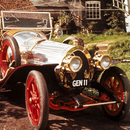Introduction: Professional Looking Mini Mic Stand on the Cheap and in a Hurry
So I got myself into a pickle. I agreed to record a session of D&D on Saturday, today is Wednesday.
Two weeks prior I picked up an Audio Interface (check), the following week I got a really good deal on some microphones (check), last weekend I made some nice short tabletop length cables (check) and today I realized what wasn’t on my list. Have you spotted it?
I have no Mic stands.
Not much of a reveal given the title I know but it was a reveal to me at the time let me tell you.
Not wanting to spend 15 bucks a piece for them and not wanting to make everyone hold their own mic for five or more hours I decided I would make them in a night with things I could find at the stores along my commute home from work and whatever else I had on hand.
Step 1: Materials
Solar Garden Light (Dollar Store)
2.5lbs Disc Weight (Thrift Store)
Mic Clip (freeby with microphones)
Epoxy
Super Glue
Hammered Finish Paint
Painters Tape
Gumption
Step 2: Solar Light Prep
Remove the light housing and set it aside, we just want the tube and the spike for this project.
We need to clip the spike in two places.
First from the top section we want about an inch of material, half to be set into the weight, half to slide into the tube as intended. I used the plastic ribbing as a guide on mine.
Next we want to cut off the pointy end of the spike, we want about 2"-3" of material along with some of the taper left to thread in to the mic clip.
Step 3: Base
Cover the central hole of the weight thoroughly on one side with painters tape. One layer should be plenty but make sure to firmly press it down to create a seal. Next place the small 1" piece of spike cut side down in the center making sure to stick it to the tape.
Step 4: Mic Clip
Press and thread the narrow end of the remaining piece of spike into the threading of the mic clip. You don't want this crushed all they way in but close. Leaving a small gap at the base will allow the epoxy to flow between the four quadrants, this will also help with managing air bubbles. Go slow and take your time, the plastic of these spikes is somewhat brittle and prone to break if forced.
Step 5: Glue Up
Make sure to cover your work space to catch any spills and secure each piece before starting. The weight does a fine job of securing itself on a flat surface but the mic clip is a bit more tricky. I ended up using my soldering third hand to hold mine steady.
Mix up a batch of epoxy, a bit less than a table spoon of each part should be more than enough for each stand. Working quickly, first fill the central void in the weight with the spike piece still in place. You may need to add more as air bubbles escape.
Next fill in the gaps between the threads and the tabs of the solar spike on the mic clip. This can be tough to do, don't worry about some getting on the main part of the spike though as it will be hidden in the final product.
If you have any epoxy left over you can smear it into the embossed numbers on the weight to make the top a more uniform surface.
Step 6: Paint and More Glue
Once the epoxy has fully cured we can glue the mic clip assembly into the tube. This can be done with more epoxy but I opted for a couple of dabs of super glue for mine.
For the bases I decided to hit them with a hammered finish black paint. The texture will both match the solar tubes and help make any irregularities in the surface of the weight look more intentional. It also lends the whole thing more of that professional vibe we're going for by imitating the cast iron of many mic stand bases.
Step 7: Relax and Enjoy the Show!
Once all the glue and paint has dried all that's left is putting the two pieces together, sliding a mic in the top, and setting the whole assembly in front of a talkative person.
For an extra bit of non-surface marring class a piece of felt can be glued to the base and cut to shape.
Hope you found this helpful and I can't wait to see and hear what you make with it!








![Tim's Mechanical Spider Leg [LU9685-20CU]](https://content.instructables.com/FFB/5R4I/LVKZ6G6R/FFB5R4ILVKZ6G6R.png?auto=webp&crop=1.2%3A1&frame=1&width=306)


